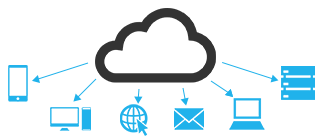All technical products are migrating their technology to the innovative philosophy of cloud.
.

Cloud computing is a paradigm of providing services on demand from a supplier to an end customer over the Internet (such as storage, processing or data transmission), starting from a set of pre-existing resources, configurable and available remotely in the form of distributed architecture.
The resources are not fully configured and implemented by the supplier specifically for the user, but are assigned, quickly and conveniently, thanks to automated procedures, starting from a set of resources shared with other users leaving the user part of the burden of configuration. When the user releases the resource, it is similarly reconfigured in its initial state and made available again in the shared pool of resources, with the same speed and economy for the supplier.
“Cloud” is not simply synonymous with the Internet and is not a technology that simply serves to save data and information on a remote server. Cloud computing is a model for structuring IT resources that redefines the way we are used to managing our IT systems and makes the entire management of IT by a company more agile.
Among the benefits that this technological revolution brings with it, we remember:
- global accessibility, services are accessible from multiple devices, multiple locations and at any time.
- hardware management by the service provider, the end user will not have to have specific hardware to use the services because the servers and databases necessary for the proper functioning of the service will be fully managed by the provider
- real time updates, all devices connected to the software will have immediate access to the data entered by other users connected to the network.
.
We immediately associate the concept of Cloud with that of security.
 Daniele Longo
Daniele LongoCTO
@ Starsystem IT
Pubblicato il 4 September 2019




 Starsystem IT srl Business Center “Ponte Regio”, Loc. Fratte, 49 – 38057 Pergine Valsugana, Trentino, Italy
Starsystem IT srl Business Center “Ponte Regio”, Loc. Fratte, 49 – 38057 Pergine Valsugana, Trentino, Italy